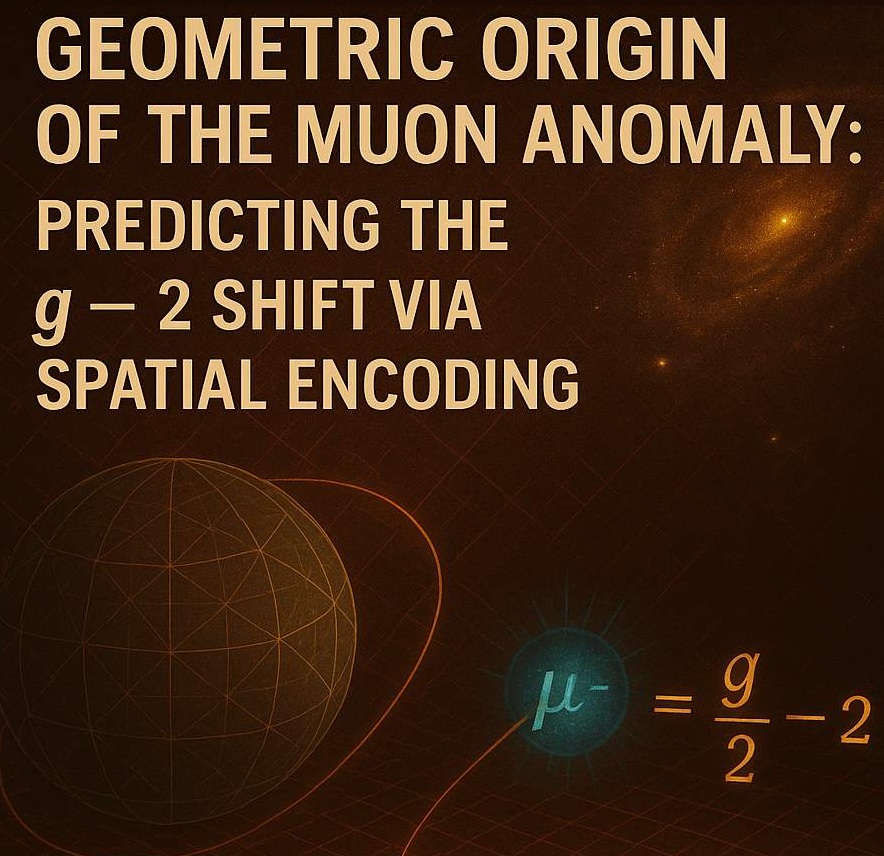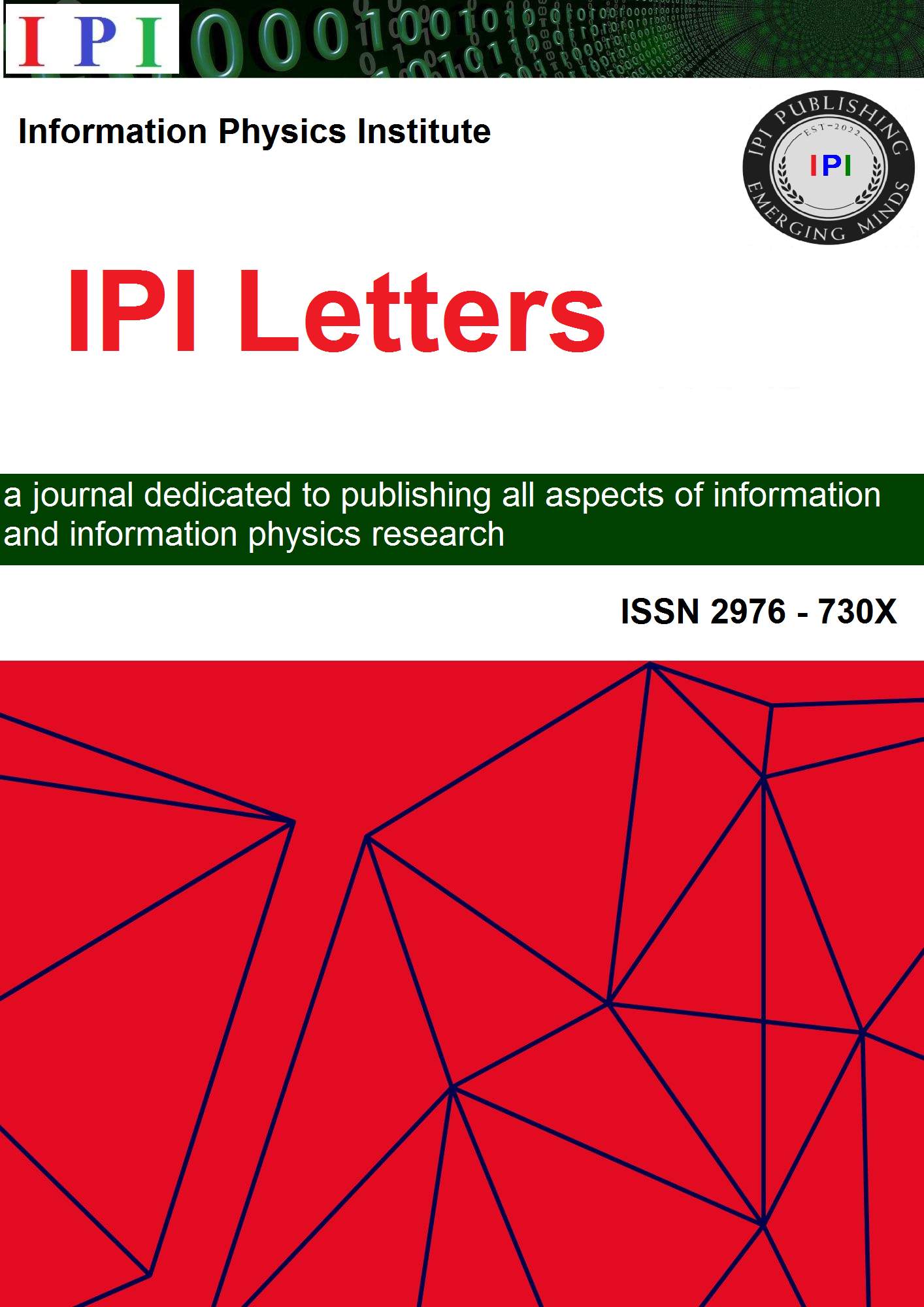Geometric Origin of the Muon Anomaly: Predicting the g − 2 Shift via Spatial Encoding
DOI:
https://doi.org/10.59973/ipil.214Keywords:
Spatial encoding, Muon g-2 , Muon anomoly, Oscillatory geometry, Oscillatory spatial encoding, Emergent dimensionalityAbstract
The longstanding 4.2 σ discrepancy in the muon’s anomalous magnetic moment provides a rare, high-precision window into physics beyond the perturbative Standard Model. We trace this deviation to geometric phases accumulated by the muon’s wave-function as it winds through compact extra dimensions. Modeling the muon as a quantized vibrational mode on a six-torus (T6) we derive a deterministic correction of (249 ± 12) × 10−11 that reproduces current measurements without new particles or forces. The framework predicts an electron shift below 10−15, a tau-lepton anomaly of (7.5 ± 0.5) × 10−9, and an energy-dependent resonance in μ+μ− collisions above Ec ∼ 100 TeV. These results suggest that lepton properties encode geometric information about space-time’s hidden structure.
References
B. Abi et al. (Muon g-2 Collaboration), “Measurement of the positive muon anomalous magnetic moment to 0.20 ppm,” Phys. Rev. Lett. 132, 161801 (2024).
Muon g-2 Collaboration, “Muon g-2 announces most precise measurement of the magnetic anomaly of the muon,” Fermilab Press Release, June 3, 2025. Available online: https://news.fnal.gov/2025/06/ muon-g-2-most-precise-measurement-of-muon-magnetic-anomaly/.
R. S. Phillips, “Anisotropic Semi-Dirac Inertial Mass: The Spatial Encoding Hypothesis,” IPI Letters 3, 117 (2025). DOI: https://doi.org/10.59973/ipil.200
M. Kalb and P. Ramond, “Classical direct interstring action,” Phys. Rev. D 9, 2273–2284 (1974). DOI: https://doi.org/10.1103/PhysRevD.9.2273
T. Kaluza, “Zum Unit¨atsproblem der Physik,” Sitzungsber. Preuss. Akad. Wiss. Berlin (Math. Phys.), pp. 966–972 (1921).
O. Klein, “Quantentheorie und f¨unfdimensionale Relativit¨atstheorie,” Z. Phys. 37, 895–906 (1926). DOI: https://doi.org/10.1007/BF01397481
K. Kikkawa and M. Yamasaki, “Casimir effects in superstring theories,” Phys. Lett. B 149, 357–360 (1984). DOI: https://doi.org/10.1016/0370-2693(84)90423-4
M. B. Green and J. H. Schwarz, “Anomaly cancellations in supersymmetric D = 10 gauge theory and superstring theory,” Phys. Lett. B 149, 117–122 (1984). DOI: https://doi.org/10.1016/0370-2693(84)91565-X
M. B. Green, J. H. Schwarz, and E. Witten, Superstring Theory, Volume 1: Introduction, Cambridge University Press (1987).
D. S. Freed and E. Witten, “Anomalies in string theory with D-branes,” Asian J. Math. 3, 819–851 (1999), arXiv:hep-th/9907189. DOI: https://doi.org/10.4310/AJM.1999.v3.n4.a6
L. Susskind, “Computational Complexity and Black Hole Horizons,” Fortschr. Phys.64, 24–43 (2016); Addendum: Fortschr. Phys. 64, 44–48 (2016).
M. M. Vopson, “The second law of infodynamics and its implications for the simulated universe hypothesis,” AIP Advances 13, 105308 (2023). DOI: https://doi.org/10.1063/5.0173278
L. Randall and R. Sundrum, “Large Mass Hierarchy from a Small Extra Dimension,” Phys. Rev. Lett. 83, 3370–3373 (1999). DOI: https://doi.org/10.1103/PhysRevLett.83.3370
L. Randall and R. Sundrum, “An Alternative to Compactification,” Phys. Rev. Lett. 83, 4690–4693 (1999). DOI: https://doi.org/10.1103/PhysRevLett.83.4690

Downloads
Published
Versions
- 2025-08-08 (2)
- 2025-08-08 (1)
How to Cite
Issue
Section
License
Copyright (c) 2025 Richard Phillips

This work is licensed under a Creative Commons Attribution 4.0 International License.













